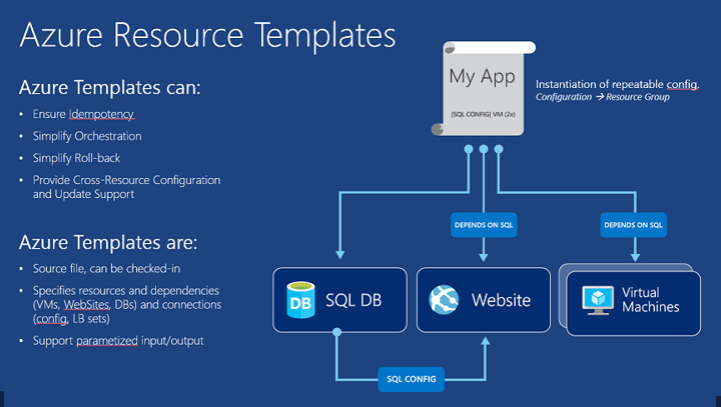Governance & Manageability (part 2)
Azure Resource Manager Templates
You can easily deploy the templates multiple times to the same resource group with the same outcome which is useful when you want to recreate an original deployment or remediate any issues resulting from post-deployment changes.
Templates also supports VM extensions, allowing you to configure operating systems within Azure VMs as a part of their deployment. These extensions includes configuration management services, such as Power-Shell Desired State Configuration, Chef, or Puppet.
Security & Compliance Services
Azure Security Center can help you to streamline the process for meeting the regulatory compliance requirements, using the Regulatory compliance dashboard where the Security Center provides insights into your compliance posture based on continuous assessments of your Azure environment. These assessments analyzes the risk factors in your hybrid cloud environment in accordance with security best practices and are mapped to compliance controls from a supported set of standards. In the Regulatory compliance dashboard, you can have a clear view of the status of all these assessments within your environment in accordance with security best practices.
Monitoring, Logging, & Alerting services
Azure Monitor consists of one of the core components of the Microsoft strategy to provide comprehensive cloud-based monitoring functionality. Other Azure manageability features are:
- Azure Advisor- Uses resource usage telemetry to provide the recommendations regarding optimizing resource configuration from the standpoint of performance, security, and availability.
- Azure Service Health- Reports platform related issues that might affect your resources,
- Azure Active Log- Tracks events representing operations that alters the state of your resources, such as configuration changes, service health incidents, and auto-scale operations.
All of the above services also complements several other services that delivers more focused, in-depth monitoring capabilities:
- Deep Infrastructure Monitoring- Besides detailed monitoring, these services also provides analytics capabilities targeting Azure infrastructure. Some of the prime examples includes Log Analytics combined with such management solutions as Container Monitoring, or Service Map, as well as a number of network monitoring tools, such as Network Watcher, Network Performance Monitor, ExpressRoute Monitor, DNS Analytics, and Service Endpoint Monitor.
- Deep Application Monitoring- This category includes Azure Application Insights, which facilitates the monitoring of performance, availability, and usage of web-based applications, regardless of their locations.
All these capabilities allows you to configure and view performance related settings, such as monitoring, diagnostics, and auto-scaling for a wide range Azure resources in the same, consistent manner.
Azure Monitor Support for Alerting
- Classic merit alerts with minimum frequency of 5 minutes.
- Near real time metric alerts with the minimum frequency of 1 minute allowing you to trigger a metric-based alert within 1 minute following a change in the metrics that satisfies the alert condition, making the Azure Monitor-based approach suitable for time critical scenarios. It also offers other advantages like:
- Support for action groups, which are the collections of settings that designate recipients of alerts notifications and the corresponding notification actions. The action types includes initiating a voice call or a text, sending an email, calling a webhook, forwarding data to an IT Service Management tool such as ServiceNow, calling an Azure App Service app, or invoking an Automation runbook. Creating such action groups allows you to reuse the same notification settings for multiple alerts.
- Alerts that consider conditions of two or more metrics.
- Multi-dimensional metric-based alerts that allows you to generate alerts based on one or more dimensions of a metric.
- Alerts that supports such conditions as average and total, in addition to minimum and maximum values available with classic metric alerts.
- Classic activity log alerts- parsing streaming log data, responding to the events such as Service Health incident or deletion of an Azure VM.
- Activity log alerts, which functions similarly to classic activity log alerts but supports configuration by using Azure Resource Manager templates.




Comments
Post a Comment